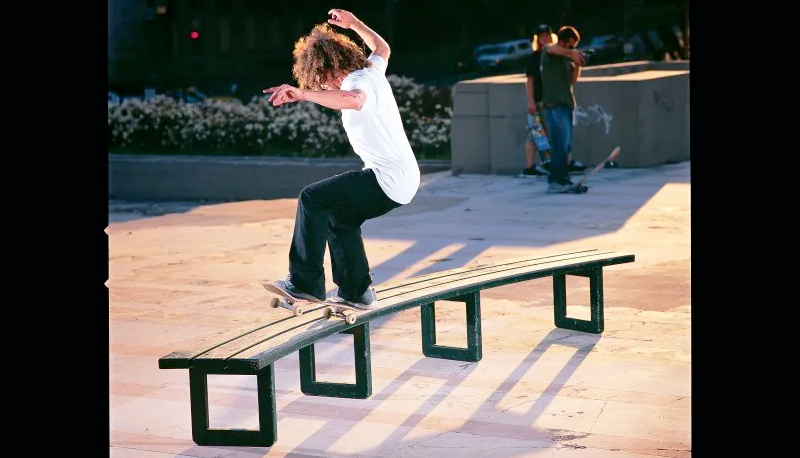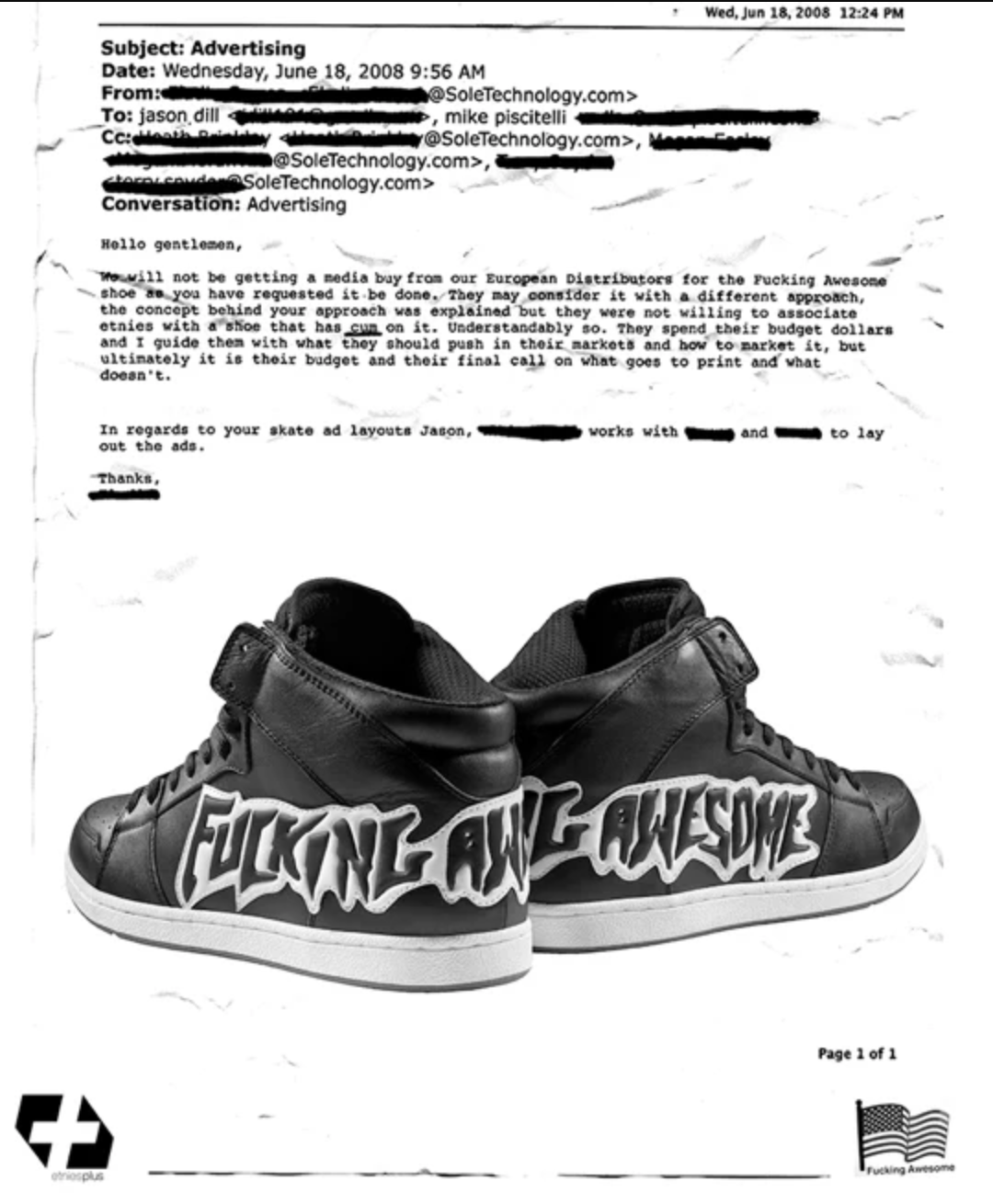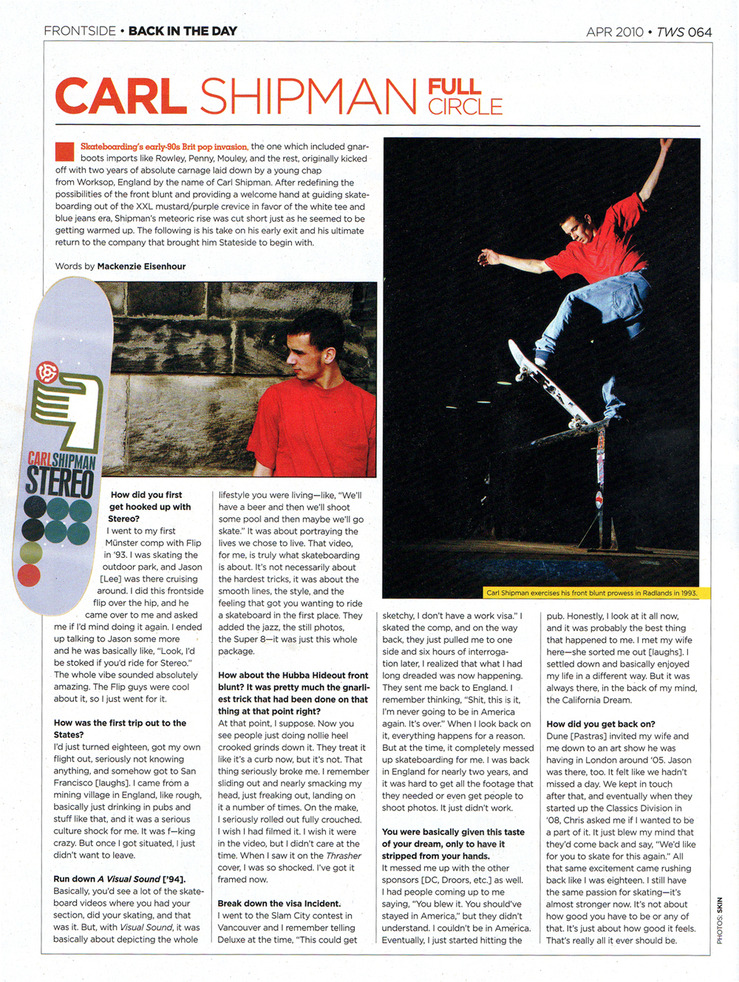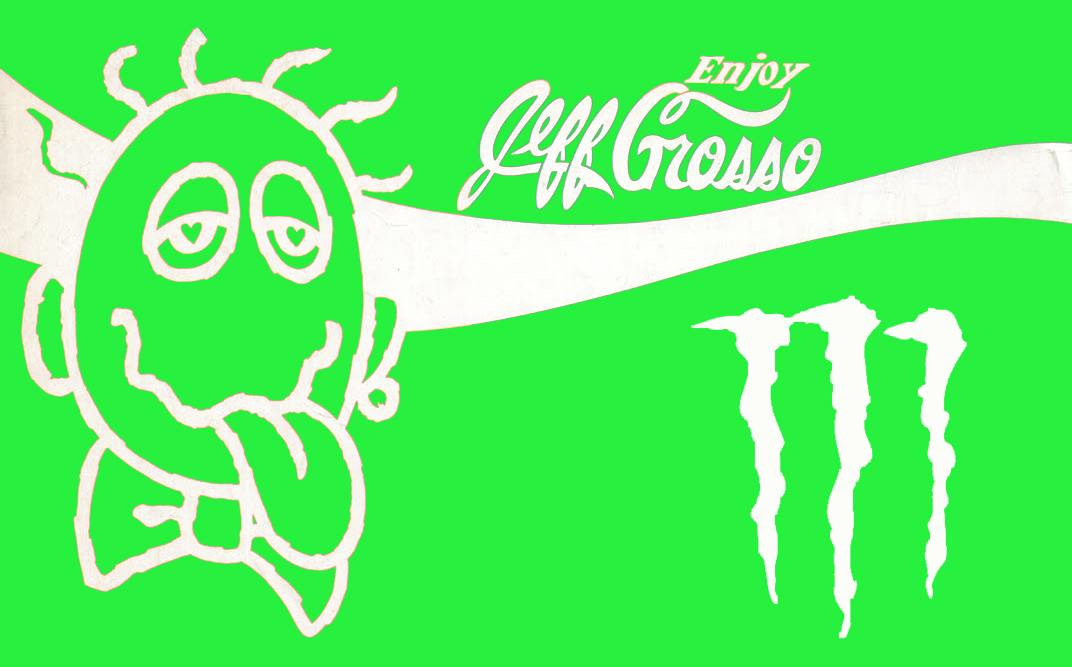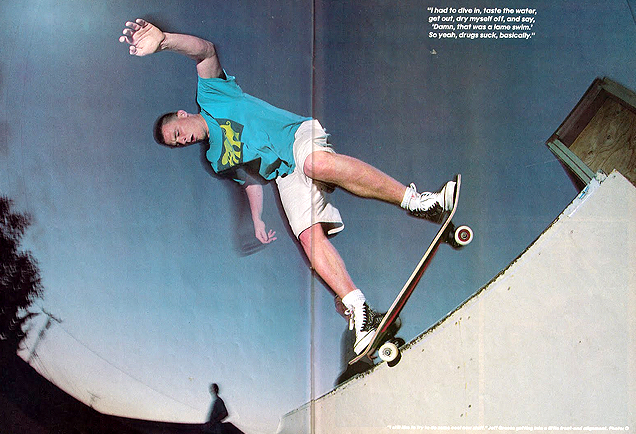Arto Saari - Alaia Issue 2 - Full Text - Summer 2023
 Tuesday, November 14, 2023 at 11:34AM
Tuesday, November 14, 2023 at 11:34AM 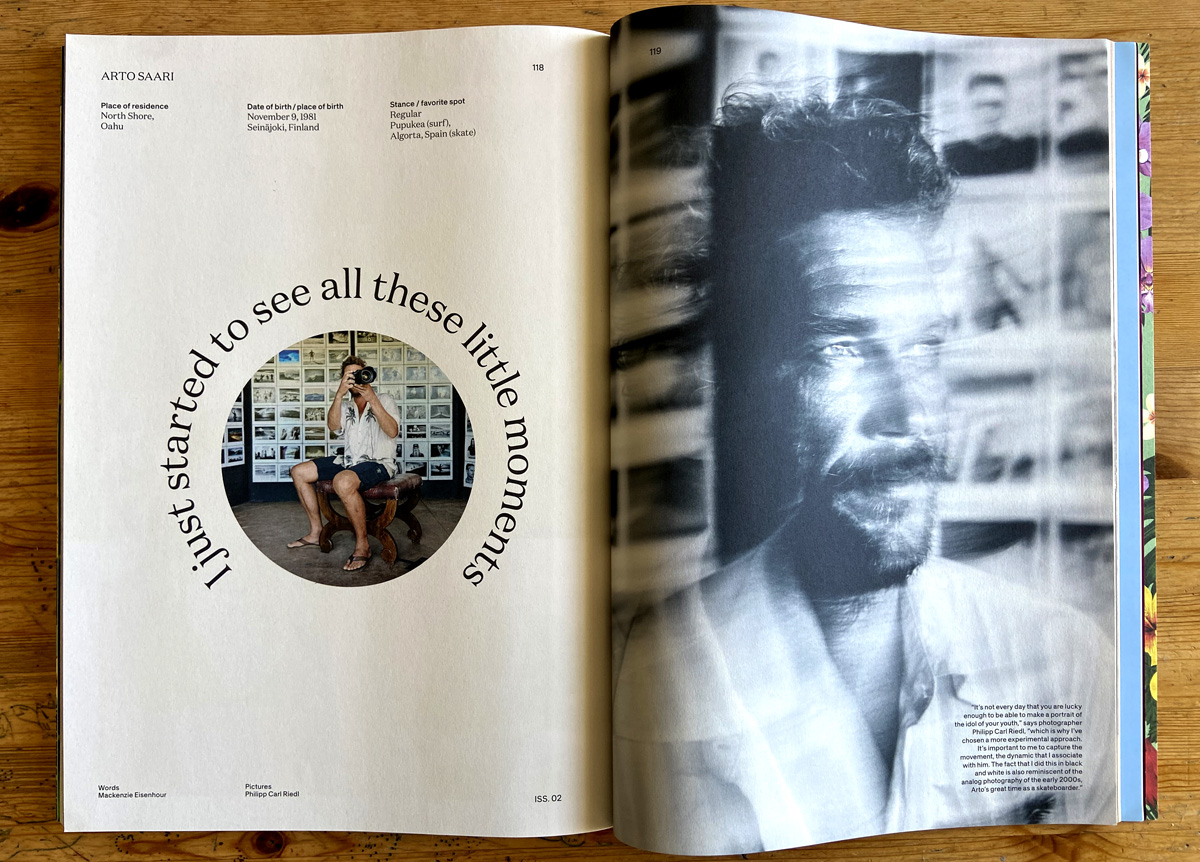
ARTO SAARI: FINNISH ENDLESS SUMMER
Words: Mackenzie Eisenhour
What are the odds of a young Finn finding his way to Huntington Beach, California to get paid to ride a skateboard? Now what are the odds of that same Finn selling his home in Southern California to become a legitimate North Shore local and surf photographer? However slim those odds may be—this is the story of one man who defied them.
Arto Saari was born in Seinäjoki, Finland in 1981 and rose up through the ranks of amateur then professional skateboarding to win Thrasher’s coveted “Skater of the Year” award in 2001. After skating to two David Bowie songs* in Flip Skateboards’ blockbuster release Sorry that same year (in what is still deemed by many as one of the best video parts of all time), and getting his first pro model shoe from éS in ‘02—Arto appeared to be on top of the skateboarding world—poised for decades of dominance.
Yet only a year later, a knee injury sustained while filming for Flip’s follow up release, Really Sorry would set into motion a series of six subsequent knee surgeries, and by 2016 his body was simply too battered to continue skateboarding. Struggling to find a new creative path forward, Arto would ultimately move his fledgling family from the heart of Los Angeles to the North Shore of Oahu, trading in his skateboard stunts for his newfound passion for surfing and surf photography. In the Spring of 2023, I sat down for a conversation with him on his life’s unlikely second chapter.
His first taste of Hawaii and surfing back in ’99 did not go well. In fact, he almost drowned. In Arto’s words, “My first visit to Hawaii was an éS trip right around when Ménikmati came out. We skated the Hickam Air Force base and a few spots on Oahu. Somebody thought it would be a good idea to take a bunch of skaters out surfing for the first time. They gave us some like potato chip performance short boards and we went to Diamond Head and got in from the cliffs. We played around in the water for a few hours then it was getting dark and all of the sudden I’m stuck in the current getting swept out to sea. And by that point I couldn’t even move my arms, we had been out for so long already. I could just see the land getting further and further away. It’s getting dark and my whole crew is just walking up the cliff.”
Panicked, Arto thought he was going to die: “There’s nobody around at this point. I was stuck in this current going nowhere—screaming, kicking, waving my arms. I remember basically just giving up. I was just like, ‘I’m fucked. This is it.’ To this day I don’t even know if it was real or not but all of the sudden I felt this little push. This local braddahcomes from behind me like, “Hello Brah, you need some help?” Like a big old Hawaiian guy and he’s just pushing my board and gets me all the way into the shore. Basically saves my life. That was my introduction to surfing.”
Saari elaborates: “After that I remember thinking, ‘I’ll just stick to what I know. Give me a handrail and some stairs. I’m good on this surfing thing. Otherwise I’ll just die.’ 16 years later, not until 2016—I was like, ‘You know what? I’m gonna try this surfing thing again.’”
I asked him what prompted a return to something that almost killed him the first time. He replies, “By ’16, I was going on a lot of skate trips, shooting a bunch of photos, but my skateboarding was just not happening anymore. I had really bad arthritis in my knee. It was such a sad thing to let go of riding a board. I had photography but I really didn’t know what to do with myself. I went to a friend’s wedding in Mexico, and this Finnish/Mexican pro surfer Kalle Carranza was there. He lent me a board and took me out. It was mostly flat that day, but he pushed me into this little six-inch peeler and I just felt this force pick me up. I felt this glide and that was enough. I came home, went to the Burton store and got the biggest surfboard they had. I started driving to the coast every day for a year in LA—never catching a wave. Finally, I was like, ‘Fuck it, I’m 35 years old. If I want to learn how to surf I need to go where there’s a lot of waves all year round.’ That’s what prompted the move to Hawaii.”
So Arto sold his house on Fairfax in Hollywood and moved his seven-month pregnant wife and toddler daughter into what he describes as a cement shack on the North Shore. As Saari explains, “We had planned to do a home birth. I basically moved her into this house that looked like a public bathroom. It’s an old brick house and it was completely gutted. When the doula came over to see where we would do the birth, she walked into the house, with no plumbing, no electrical. She was like, “Um, is there running water?” This was like a month before the birth. Eventually she was just like, ‘Well, Jesus was born in the manger. I guess this will do.’
The Saaris did manage to get the house ready in time (just barely, with Arto’s wife yelling at the workers to leave when she began going into labor) and they would go on to build another second, larger house on the property. Arto elaborates, “I felt like the move to Hawaii lasted three-and-a-half years. During that time I didn’t even really shoot any pictures. I kind of lost my passion for photography at first. I became a construction guy basically.”
Asked when his creative mojo returned he explains; “I was on the bike path a bunch, and I would still have my camera along. If there was a gnarly swell I would go shoot Pipe (Pipeline). I’d shoot a few pictures but I was not into it. Then spending more time on the bike path, going to check the surf, taking the kids to school—I just started to see all these little moments. Not even surf photography but just portraits and scenes of daily life here—the backstage as people are getting ready to surf. That really sparked me. Once I was shooting that I started shooting more actual surfing.”
Since then Arto has become a fixture in the local North Shore scene and his photography has become his primary income. His recent collaboration with Slowtide Towels is a good example of his work’s powerful commercial appeal. While he still describes himself more as a “struggling artist” than a bonafide pro—his idyllic second act is a happy ending to an already extraordinary life arc.
Will his family stay put on the North Shore for the foreseeable future? Arto pauses, then replies, “Usually they say it takes about 2-3 years for people coming to Hawaii to either stay or bounce. Either the islands take you in or people can’t deal with it and leave. We’ve been here five years now, almost six. I think we have grown some roots and are becoming a part of the community. The kids love it, this is all they know. There are more world class waves on this short, couple of miles stretch than anywhere else in the world. I couldn’t imagine going anywhere else now.”
* 1984 and Rock n’ Roll Suicide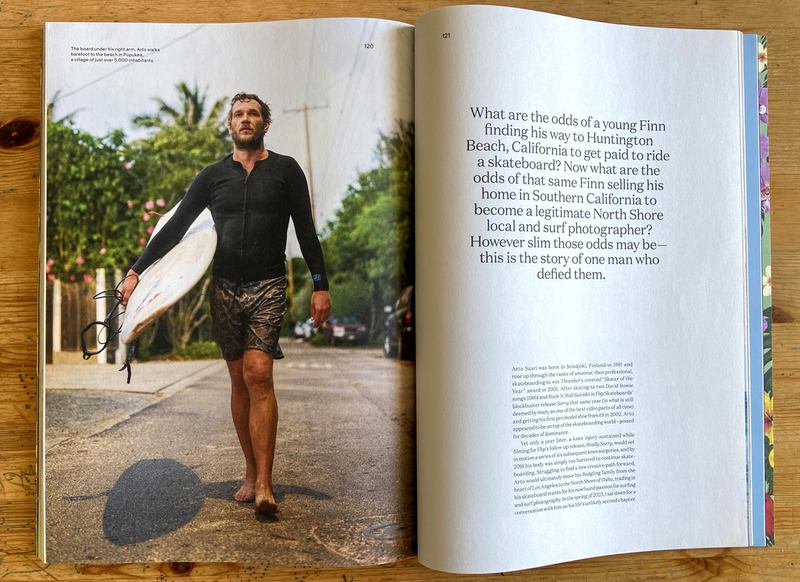
RAW INTERVIEW TEXT / CONDUCTED BY PHONE MAY 2023:
ME: Hey Arto.
Arto: Yeah buddy. What’s happening?
ME: I’m good. How are you?
Arto: Do you remember Andre Genovese?
Definitely. Like the switch ollie/switch flip beast.
He’s my neighbor now. I just ran into him. He randomly hit me up a few years ago to see if I knew anybody renting a house here. So I told him like, “Yeah, call these couple of people.” I didn’t hear from him for a few months and then he just showed up like, “Dude I just rented a place. It’s like two houses over from yours.”
He rode for Hurley when I worked for Hurley.
That’s right he was a Hurley guy.
When did you first visit Hawaii?
My first visit to Hawaii I think was an éS trip with Atiba (Jefferson) and some of the boys. I want to say it was right around when Menikmati came out and we did a demo tour. We skated the Hickam Air Force base and a few spots on Oahu. But somebody thought it would be a good idea to take a bunch of skaters out surfing for the first time. They were like, “Oh yeah, just take these boards.” And they gave us a bunch of like potato chip performance short boards and were just like, “Paddle out there.” So we went to Diamond Head and got in from the cliffs. We played around in the water for a few hours then it was getting dark and all of the sudden I’m stuck in the current getting swept out to sea. And by that point I couldn’t even move my arms. They were just like spaghetti noodles—we had been out for so long already. I could just see the land getting further and further away. It’s getting darker and darker and my whole crew is just walking up the cliff.
Jesus.
There’s nobody around at this point. Nobody in the water, it’s just completely empty. The waves even weren’t that big, they were probably knee high but I was stuck in this current going nowhere. Screaming, kicking, waving my arms. I remember basically just giving up paddling. I was just like, “I’m fucked. This is it.” To this day I don’t even know if it was real or not but all of the sudden I felt this little push and I started moving, I started paddling again and know I was moving toward the shore. This local bradda comes from behind me like, “Hello Bra, you need some help?” Like a big old Hawaiian guy and he’s just paddling and pushing my board and gets me all the way into the shore. Basically saves my life. That was my first introduction to surfing.
You had a guardian angel out there.
He came out of nowhere. 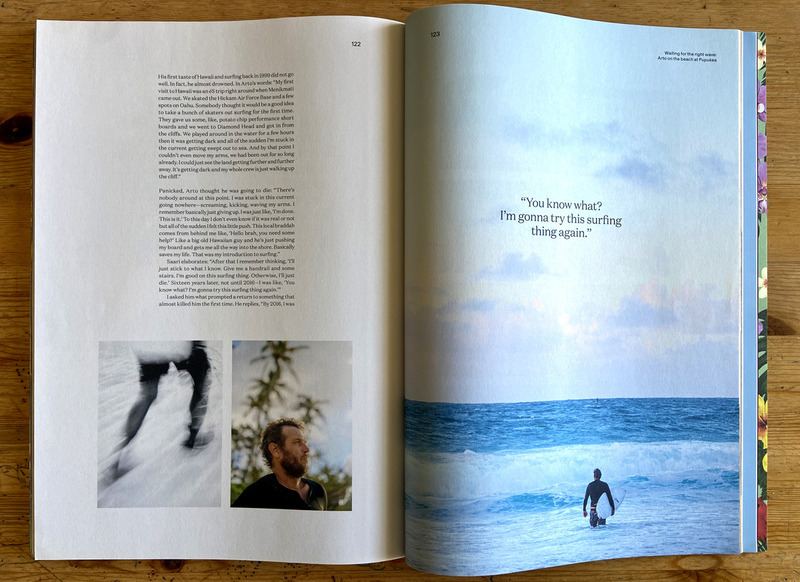
That’s a heavy first experience for surfing.
Yeah, after that I remember thinking like, “I’ll just stick to what I know. Give me a handrail and some stairs. I’m good on this surfing thing. Otherwise I’ll just die.” 16 years later, not until 2016—I was like, “You know what? I’m gonna try this surfing thing again.”
So it wasn’t love at first sight with Hawaii and surfing?
Oh hell no. I mean I lived in Huntington Beach for 10 years and I was maybe in the water a handful of times just to swim. I never even thought about surfing. It was not even on my radar.
What made it come back around in 2016?
At that point I was going on a lot of trips, shooting a bunch of photos, and just feeling pretty shitty physically. I was pretty cooked. At that point my skateboarding was just not happening any more. I felt like, “I can’t move.” It was such a sad thing to let go of riding a board. I had photography but I really didn’t know what to do with myself. It was a tough mental battle. I went to a friend’s wedding in Mexico, and this Finnish/Mexican pro surfer Kalle Carranza—he’s a buddy of mine, he was there and he was like, “Let me take you out surfing. Just grab a board from my surf shop and I’ll show you.” It was basically flat that day, there were no waves. But he pushed me into this little six-inch peeler and I just felt this force pick me up. I felt this glide and that was enough. I came home, went to the Burton store (At the time Arto rode for Alien Workshop which had then been bought by Burton) and got the biggest surfboard they had and started driving to the coast every day for like a year. Never catching a wave so at that point I was like, “Fuck it, I’m 35 years old. If I want to learn how to surf I need to go where there’s a lot of waves all year round.” That’s what prompted the move to Hawaii.
I heard that you were trying for a second to move out there. Waiting for something to open up to buy on the North Shore?
Yeah, during that year that I was heading to the coast in LA trying to surf these developers were trying to buy our house on Fairfax. So it was sort of the perfect storm. These developers kept knocking on our door like, “Hey, we want to buy your house.” We had already decided to move, we just didn’t know where. That’s when I decided on Hawaii. It was kind of weird, all these forces simultaneously occurred. We had sold our house on Fairfax and were half way through the escrow when this property popped up. My realtor called me and was like, “Hey, this is going to go fast. If you want it go gotta put an offer in right now.” I hadn’t even seen the property but he was like, “If you want it this, you have to put an offer in tomorrow.” I was like, “I’ll take it.” So I bought it sight unseen.
Just trusting the flow.
I had been watching the market there for a year and I kind of knew a little bit about it. I knew the location. I knew the prices there. But it was basically just a flat farm lot with grass on it and a tiny little house. It was built in the ‘70s and would have to be redone completely. But I was just trying to get anywhere on the island. I was looking all over and by some miracle this North Shore lot popped up and it was just perfect.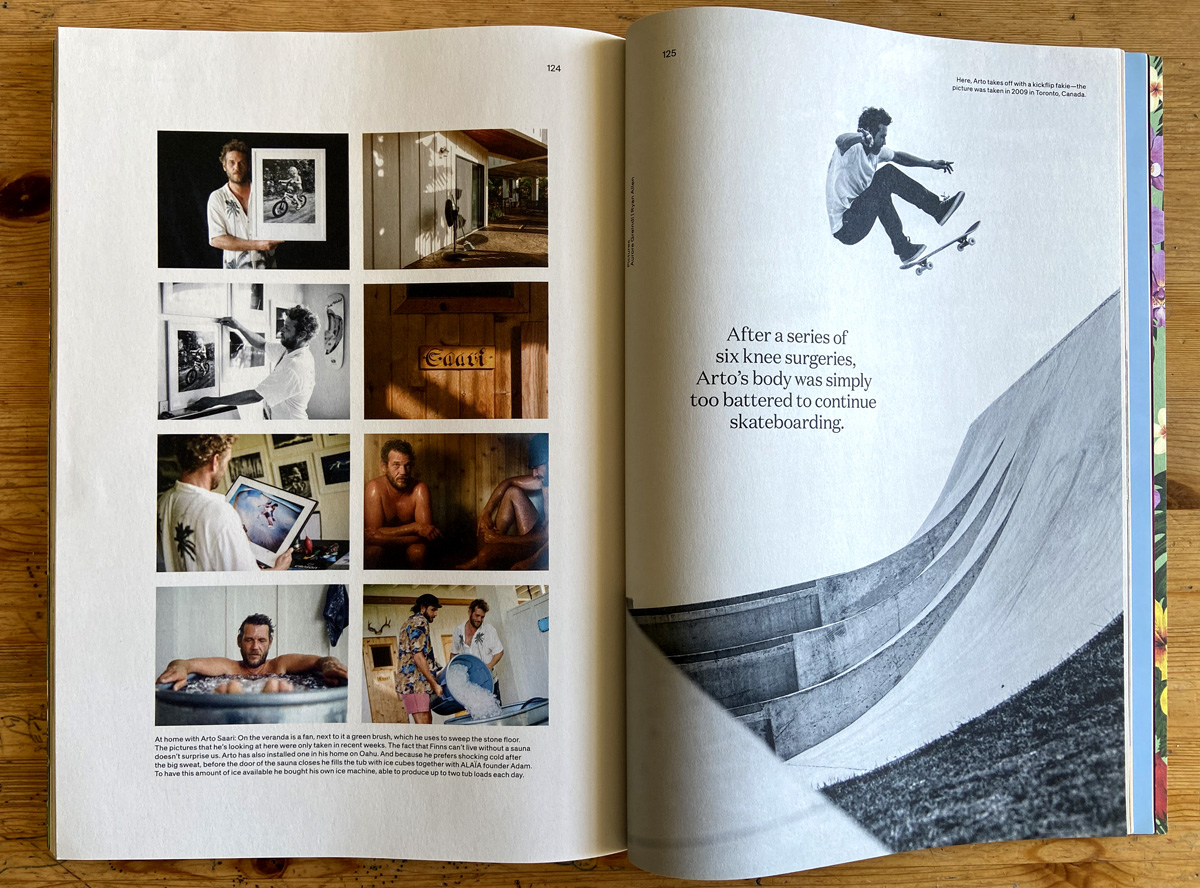
Your still in that spot right?
Yeah, still here in the same spot. We did a lot of work on it. I felt like the move to Hawaii lasted three and a half years. During that time I didn’t even really shoot any pictures. I kind of lost my passion for photography at first. I became a construction guy basically. Renovated the small house on the property, and we built a another new house from scratch. I had to put in a little ice bath and a sauna to keep the Finnish vibes going. We had a big project on our hands. After the three and half years I thought I’d just be a construction guy. I was like, “Skating is done. I’m surfing. I’ll be a contractor.” I didn’t have any passion to shoot photos. I was in a new place I didn’t know what to shoot.
Were your kids born in LA or out there?
My daughter was born in LA and my son was born here in the little house. It was a home birth. My wife was seven months pregnant when we got here. I basically moved her into this house that looked like a public bathroom. It’s an old brick house and it was completely gutted. When the doula came over to see where we would do the birth, she walked into the house, it was completely gutted with no plumbing, no electrical. It was just a brick shell with a roof. She was like, “Um, is there running water?” This was like a month before the birth. Eventually she was just like, “Well, Jesus was born in the manger. I guess this will do. As long as you have running water this will work.”
So it worked out? Your son was born there?
Yeah. I managed to finish the work in time. I got a bath tub in there, a bed, walls. It looked like a house by the time he was born. But I do remember I still had workers there when my wife was going into labor. She was screaming and there’s people putting shelves in the closet, power tools and eventually she was just like, “Get the fuck out of here!” Everyone dropped their tools and disappeared (laughs).
She’s American right? Not Finnish?
Yes, she’s American.
Sounds like a lot going on right then. Trial by fire. Did you ever officially retire from pro skating after moving out there?
No. I mean the first year I was in Hawaii I was still pretty involved with skating. Trying to work with companies. I was on New Balance at the time and working with Volcom trying to do skate stuff. It kind of became too difficult I guess for them to get me over (to the mainland). When I was in LA, every skate trip or job I went on was not in LA. Everything involved traveling. So I figured, “Why do I need to be in LA? I can just hop over in five hours—tickets are a few hundred bucks.” That was my reasoning for it. But once I got here everybody is just sort of like, “Well, your stuck on the rock, we don’t care about you.” All the connections dried up pretty fast.
When did this new passion for creating your own world out there kind of kick in? I saw the video of you taking your kids to school on the bike path and shooting photos on the way home. Was there a moment where you fell back in love with photography?
Yeah, after I got settled and moved in here—after the building project—I was on the bike path a bunch, and I would still have my camera along once in a while. If there was a gnarly swell I would go shoot Pipe (Pipeline) and I would almost feel obligated to shoot because it was so crazy. I’d shoot a few pictures but I was not into it. Then spending more time on the bike path, going to check the surf, taking the kids to school—I just started to see all these little moments along the path. I had always been really interested in photojournalism so I just started shooting people on the bike path for fun. Not even surf photography but just portraits and scenes of daily life here. Shit that goes on in the backstage basically as people are getting ready to go surf and all the action behind the scenes. That really sparked me to shoot more. Once I was shooting that I started shooting more actual surfing. 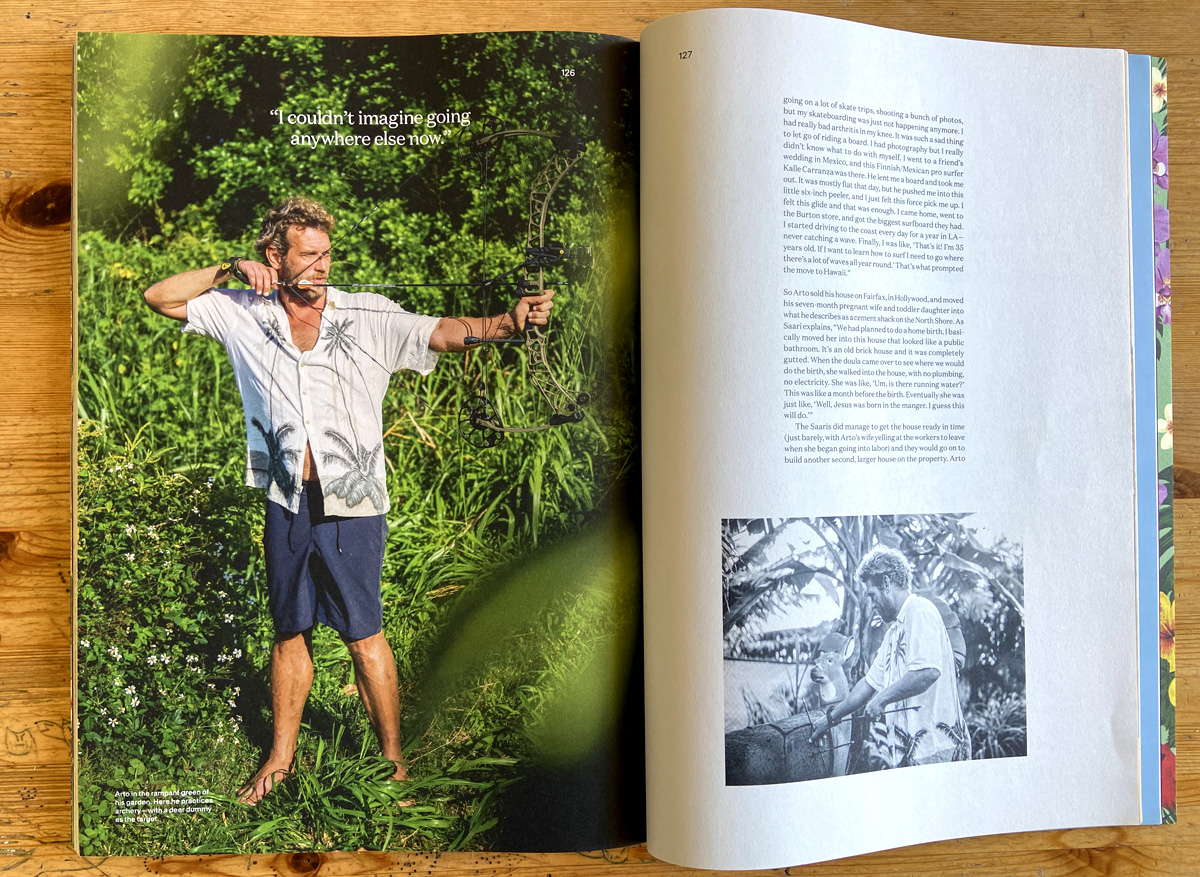
That strip on the North Shore is basically the center of the surfing universe right?
Yeah, I guess from a skater’s perspective it would be like somebody showing up at EMB (San Francisco’s Embarcadero plaza that was long considered the center of the skate universe) and starting to shoot portraits. There are more world class waves on this short, couple of miles stretch than anywhere else in the world. During the winter, from like November to February the whole surf industry is here. You can be a pro surfer anywhere but I think if you really want to make it globally and be one of the top dogs you gotta come over here and cut your teeth at Pipe (line) and surf Hawaii waves. It’s kind of like a right of passage. If you really want to be a part of the whole deal of surfing you gotta put in your time over here too.
I forgot to ask too, I know there was the first knee injury in Really Sorry (’03). Was there a key injury that changed your course or was it all of them together?
The Really Sorry one kind of started the whole chain of events.
That was the nollie?
Yeah. The nollie. I blew my PCL (Posterior Cruciate Ligament)out and the ACL (Anterior Cruciate Ligament)—that was the first surgery. Then I had five more surgeries in six years. And that was like the key time when I was supposed to be skating at my peak but I was just back-and-forth having knee surgeries the whole time. Then once I hit 30, the arthritis got so bad that they couldn’t really do much about it anymore. I had a new ACL put in for my last video part (Mindfield by Alien Workshop/Greg Hunt, 2008) and I managed to get sober for six months and finished filming but by the end I had worn out the ACL they had just put in. So that was the last time I got surgery.
It was worn out in six months? That’s heavy.
I think the knee thing definitely cut my time short. That was the big thing. I mean I got knocked out a few times. Hit my head. I’m sure there was some brain damage or whatever but it doesn’t bother me now.
When did you get settled into this new life? I assume you’re staying in Hawaii now for the long haul?
Yeah, I think I’m here for the long haul. Usually they say it takes about 2-3 years for people coming to Hawaii to either stay or bounce. Either the islands take you in or people can’t deal with it and leave. We’ve been here five years now, almost six. I think we have grown some roots and are becoming a part of the community here. The kids love it, this is all they know now so I think it’s safe to say we are here to stay. I couldn’t even imagine going anywhere else now.
You’re not moving back to Finland anytime soon?
No. Any travel I do now, the swell charts dictate where I go (laughs). That’s pretty much my calendar now. “Is there swells there?” Before all the trips were based on skate spots.
Are you able to live off your photography now on some level?
No. I don’t know if you can ever live just off photography in this day and age. I think I’m more of a struggling artist (laughs). But these last couple of winters have been pretty good. I’ve been able to get a little bit of a name in the surf industry and people started to know my photography. I’ve been getting little odd jobs throughout.
How did the Slowtide towel project come together for example?
They just hit me up. We are kind of family friends with the guy who runs the company. He actually used to be a designer for Etnies back in the day so we had a connection through that. They started their company (Slowtide) and my photos kind of fit their vibe so it made sense. But there’s a lot of commercial work too here in Hawaii. But a lot of it goes through New York. They end up bringing a whole crew out here rather than hiring locally.
Are you still focusing on black and white or do you shoot everything now?
I’m shooting everything. A lot of the stuff you see, obviously my personal obsession is black and white. The bike path project tends to live in black and white. A lot of my portraits too. But shooting for clients of course, the first thing they say is they want color.
Color is like the dazzle that the mainstream wants.
Exactly. And I get it. That’s why they come to Hawaii to shoot. They want the blue sky, clear, clean blue water, and green palm trees and flowers and the rest. But shooting in black and white has been my own artistic vibe just to entertain my artistic obsession. But I shoot a lot of color too.
Do you still draw inspiration from the skate photographers you spent all those years with—French Fred (Mortagne), Oliver (Barton), Skin (Phillips), Atiba (Jefferson)?
For sure. Those guys had such a big influence on me from the start. That was how I learned photography—by hanging out with all those dudes. My baseline comes from that. I got my first camera off Skin Phillips and all those great skate photographers had such an affect on me. But at the same time you start growing on your own as a photographer, start shooting different stuff and getting inspired by different stuff. For portraits for example, I’ve been obsessed with (Richard) Avedon forever and (Annie) Leibovitz. There’s a French guy, Raymond Depardon, I’ve been really into his black and whites of kind of mundane landscapes.
Are there photographers in surfing that you are into?
I’ve been heavily into this guy Ted Grambeau from Australia. A lot of the old school guys too like John Severson and Bob Brewer (RIP) who just passed away. I love all the classic guys. There are obviously some incredible new photographers coming up too, doing a little bit different stuff. Ben Thouard is another one. There are a lot of incredible water photographers here.
Do you ever get the itch the go skate still? I think you still have some quarterpipes in the driveway right?
I do have some quarterpipes but honestly they’re mostly for the kids. I enjoy building skate stuff now more than I enjoy physically skating them. I whipped up the quarterpipes and scratched a couple of grinds but that’s about it.
Do the kids skate hard?
My daughter kind of learned how to roll around. I also have a little concrete mini ramp on the driveway. They just kind of learned to cruise around on it. Do some turns. But my daughter is a real girl’s girl. She doesn’t really surf or skate. She dances. She likes ballet. And my boy is five and a half so he’s just kind of pushing around on his knees. The skateboard is just one of the toys. It’s not a thing yet.
My kids almost won’t do it because it’s dad’s thing or whatever. Like when we skated as kids it was rebellious or whatever. But if your parents do it I guess that changes it.
Yeah. Exactly. I’m thinking maybe if I don’t push it they’ll just naturally pick it up on their own.
I bring my kids down to Stoner Plaza all the time. They’ll roll around for a few minutes then be like, “Let’s go play tennis”. It’s just like one of the many activities. But yeah, having dad do it seems like a detractor.
I got some boards laying around. I haven’t really pushed it. To tell you the truth I don’t know if I could spend another 20 years in a skatepark.
You put in your time. I mean as skate journalists we would maybe tag along with you guys on a tour here and there. And even one tour seemed pretty exhausting. But you guys lived on those tours like permanently for decades.
I think I definitely have a little PTSD (laughs). I mean it was fun. Don’t get me wrong. It was the greatest thing ever. But at the same time, when you live and breath something for 20 years, I just feel like I have to do something different.
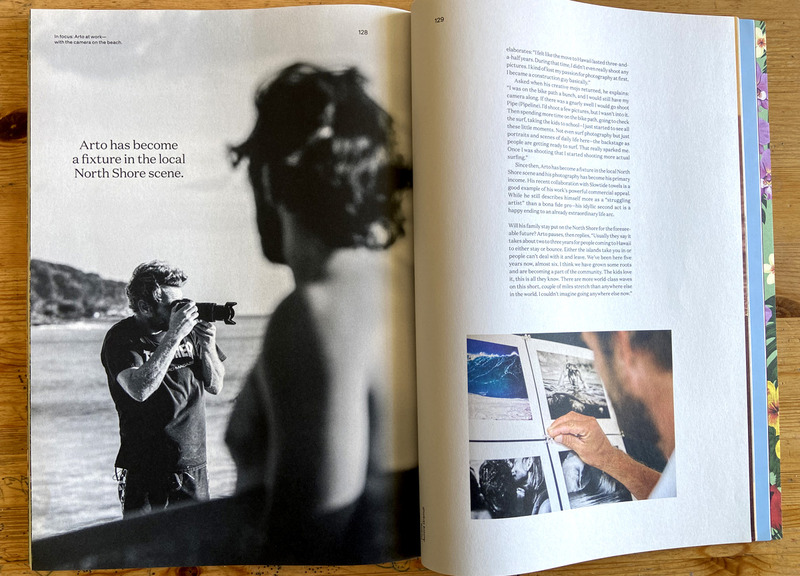
I think you have pretty much the coolest second act anyone could write.
It (skateboarding) almost killed me too a couple of times so there are just certain things that tick my brain, like, “I can’t do that anymore.” My life today pretty much consists of pulling weeds, fighting the jungle, growing papaya, taking the kids to school, surfing, and loving the bike path.
I got to say, when I was a little kid growing up in Norway we would visit Sunset Beach every summer because my aunt lived out there with my grandma and cousins. We would stay at this beach house right across from Kammy’s Market and I remember crossing that bike path in the middle to go to Kammy’s all the time. When I saw your video it brought back the craziest memories.
Yeah, Kammy’s Market was a legendary surf snack spot there. You got the best of both words—the snow and a little taste for the tropics.
Do you still have family in Finland? Do they come out to visit?
My immediate family—mom and sister have been coming out. My sister is actually coming in a month. She hasn’t seen the new place yet. My mom tries to come at least once a year to get out of the snow and see the kids.
So is this it? Do you think you will stay put on the North Shore?
I think so. I’ve been studying surfing for a couple of years now and I just cannot find a coastline with this many world class waves anywhere else in the world. Year round. Winter season the waves are on this side. But then in summertime the south side of the island starts lighting up. The island has waves all year round which is rare for anywhere in the world. It’s a slower paced country living. You’re a little isolated. You definitely give up some of the modern conveniences. But at this point in my life, I’ve never been so happy to just stay put and not get on an airplane.
I imagine for COVID it must have been amazing being there rather than some apartment in New York or somewhere.
Yeah, we got really incredibly lucky with that one. The only bummer living in Hawaii is when you have to get on a plane and go somewhere else (laughs).
All time favorite skate photographer.
It’s gotta be Dan Sturt. Favorite and maybe the worst too. He might get both titles. He’s pretty incredible. Such a character. He would say the most fucked up shit right before you were about to jump on a handrail (laughs). He’s a smart dude. He knew how to get behind your head. He always knew just how far to push it—that fine line—to get you to do the trick. And he knew just when to pull back. For most people it probably seemed a little rude and over the top. But he knew how to bring the best out of people.
Favorite surf photographer?
That’s a tough one. I’ve been more into portrait and fashion photography. I’ve been really freaking out on this guy Bastiaan Woudt. He just had a gallery show at Fahey/Klein in LA, right down the street from you. He’s from Netherlands and is more of an abstract fashion portrait photographer. If I had to pick one for surfing though I think that Ted Grambeau has been the most striking to me.
All time favorite surfer?
John Florence.
All time favorite skateboarder?
Tom Penny. It’s gotta be. Maybe the most naturally gifted skateboarder of all time.
He’s still ripping.
I think he’s been off the sauce too for the last couple of years. We see a lot more footage of him now. Rune (Gliffberg) has always been one of my favorites too. And the fact that he’s still ripping hard now is so rad.
I’m stoked for you and where you ended up man.
It definitely feels like a second lease on life. After almost dying a few times throughout the skateboarding stuff. I don’t mean to be dramatic but I think it was pretty close a few times.
You skated in probably the gnarliest time in skateboarding. When it was trendiest to go the biggest on stairs and rails.
It doesn’t seem as trendy to get gnarly anymore.
There are a few people still doing the occasional 10-kink rail or Jaws jumping down huge drops but then other people can make a full career now with low impact skating, maybe only doing ride-on grinds and slappies.
There are still a couple of guys pushing it.
Definitely.
Nyjah putting out three parts in one year with shit that you’ve never even seen before. Jaime Foy front crooked grinding like triple kinks. It’s not all ‘90s style pants and slappy grinds.
The pants got really big again though (laughs). At the skatepark over here they all have the Polar Big Boys and whatnot.
It’s like, “What happened? We already went through this.”
Pontus is smart. That’s what happened. It’s all a cycle. If we wear tight pants it’s only a matter of time until someone is like, “Fuck tight pants. I’m going baggy!” And then a few years later someone else will be the new Boulala like, “Fuck baggy, I’m going skin tight!”
Yeah, you gotta keep your finger on the pulse.
Thanks to Arto and Alaia Mag. Photos by Philipp Carl Riedl, Ryan Allen, Aurore Greindl. Layout: Sophie Weidinger. Editor: Wolfgang Weiser. Creative Director: Markus Kietreiber

